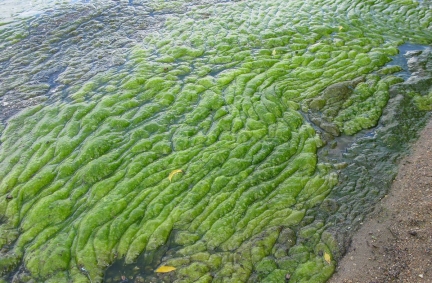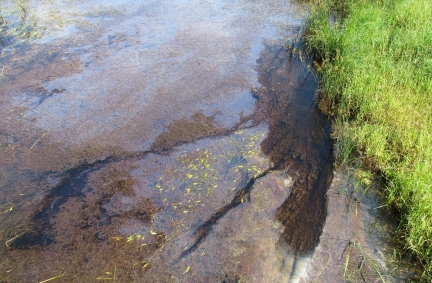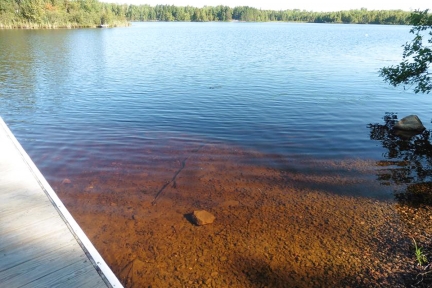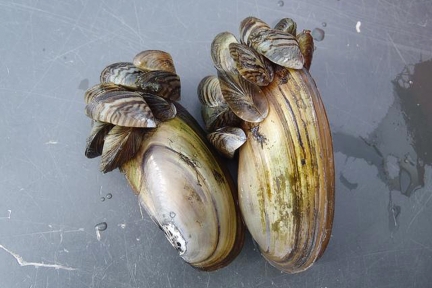What is the blue-green scum that looks like spilled paint?
In lakes that are over-enriched with phosphorus and nitrogen, algae tend to prosper and create algae blooms. Blue-green algae and one type in particular, cyanophytes, can be harmful to humans and pets. Learn more on the Blue-green algae and harmful algal blooms page.
What is the green stuff that looks like fluffy clouds or cotton candy?

It's probably filamentous algae, sometimes called moss or pond scum. This is a common and troublesome aquatic plant that forms dense, hair-like mats. Filamentous algae form on near-shore bottom sediments or submerged objects in ponds and lakes where there is good transparency and where sunlight reaches the bottom of the pond or lake. As the algae grow, they produce oxygen that gets trapped in the entangled strands of algae. This trapped oxygen makes the algae buoyant and causes it to rise to the surface of the pond or lake. Some of the more common forms of filamentous algae can be identified by their texture, although microscopic examination is usually required for exact recognition. Cladophora feels cottony, while Spirogyra is bright green and very slimy to the touch. Pithophora (or horse hair) has a very coarse texture like horse hair or steel wool. The best method for homeowners to remove filamentous algae is to rake out the floating clumps and limit the nutrients that reach the water from their property. You can compost these piles or use them in your garden as mulch. NOTE: Chemical control of aquatic plants requires a permit from the Minnesota Department of Natural Resources.
What is causing the oil-like sheen on the water?

This rainbow or iridescent sheen looks like what you see when oil, gasoline, or other petroleum product is spilled on water. If there isn’t an obvious source of petroleum and no petroleum odor, the sheen is likely the result of bacteria. If you try to break up the sheen with a stick or rock and it breaks into small pieces, it is a bacterial sheen. If it quickly reforms, then it is likely a petroleum-based sheen. If your lake or river has stormwater outfalls, or drains a parking lot or road, it is typical to see a sheen after a rainfall. It will evaporate or be broken down by microbes. If it is a larger sheen resulting from a spill, please report the spill to the Minnesota Duty Officer at 800-422-0798.
What causes that yellowish powder or dust on water?
The powder you are seeing is most likely pine pollen. It is very common to see it in late spring to early summer. After becoming waterlogged, the pollen sinks to the bottom. This is a natural event and shouldn't affect the overall water quality.
What causes foam to gather on the shoreline?
In most instances, the foam we see on the surface of lakes and streams is natural. It's created when air mixes with natural organic compounds, such as decomposing plants and animals. The mixing or agitation in lakes is commonly caused by wind and wave action; in streams, it may result from water flowing through rapids or over a dam. Like other things that float on the surface, the foam will often collect on a downwind or downstream shore, and although it may not be aesthetically pleasing, it is natural and harmless. Natural foam tends to off-white, tan, or brown and have a fishy odor. Foam caused by detergents will often be white and may have a perfume smell.
PFAS foam on surface water
Most foam observed in lakes or streams is naturally occurring, and not an indicator of pollution. However, PFAS can also sometimes cause foaming on surface waters. In 2019 and 2020, foam containing PFAS was found in Battle Creek in St. Paul, between Battle Creek Lake and Highway 61. Water samples collected in the same area showed much lower levels of PFAS.
If in doubt, stay out
PFAS-containing foam on surface water isn't a risk to human health if contact is minor. The MN Department of Health recommends avoiding contact with PFAS-containing foam. Surface water concentrations of PFAS are much lower, indicating water is safe for recreation. PFAS are poorly absorbed through skin and swallowing small amounts of water while swimming will not result in significant exposure.
Why is the water yellow or green during the summer?
Algae grow in lakes during warm summer months. In the late winter and early spring, algae are made up of diatoms, which can give the water a yellowish hue during a bloom, or period of high growth. In some bodies of water, green algae are present in late spring and early summer, with strands of filamentous (stringy or hair-like) algae forming on rooted plants or washing up on shore. In warmer months, the algae can transition into blue-green algae. These can give the water a vibrant green hue and where they form dense mats, can create a smelly, blue-green to gray scum. Cooler temperatures, rain, and wind can help dissipate these blooms.
What causes a root-beer color in some lakes?

Sometimes described as root beer, coffee, tea, or bog stain, such coloring is natural for waters throughout Minnesota, but it tends to occur more frequently in northern Minnesota. The coloration is not harmful and results from incompletely dissolved organic materials, sometimes referred to as tannins, coming from wetland plants in the lake's watershed. The shade of the water is often proportional to the quantity of wetlands in the watershed. Northern Minnesota watersheds are predominantly forests and wetlands, so lakes in the region can have very dark coloration, which can limit water transparency.
What causes swimmers itch?
Swimmer's itch is caused by a blood fluke, a parasitic worm common in waterfowl. When the fluke, early in its life cycle, mistakes you for a waterfowl and burrows into your skin, you may feel itchy. But the fluke is harmless to people, aside from the annoying itching. Learn more about swimmer's itch and how to avoid it on the Minnesota DNR's web site.
How does a lot of boat traffic affect water quality?
A 1996 Wisconsin Department of Natural Resources study — "Impacts of Motor Boats on Water Quality in Wisconsin Lakes" — investigated the impact of boat traffic on water quality. It looked mainly at traffic issues, and did not address the impact of the oil and gas used in boat motors. Some general conclusions from the report:
- Boat counts doubled or tripled on average during most weekends
- Water clarity was temporarily reduced by nearly 10% on weekends, due to increased turbidity.
- Shallow lakes and near-shore areas are more affected than deeper lakes.
- Boat traffic may stimulate algal growth in lakes containing soft-water sediments.
The study suggested that impacts on aquatic plant communities and shoreline erosion need to be studied further.
Another Wisconsin study looking at the effects of motor boats on submerged plants — "Effects of Motor Boats on Submerged Aquatic Macrophytes" — was printed in the Journal of Lake and Reservoir Management 13(1):1-12, 1997. This paper concludes that motor boat traffic reduces plant biomass primarily through direct cutting and scouring of sediments.
A 2004 study by the Minnesota DNR on shoreline and water quality impacts from recreational boating on the Mississippi River concluded that sedimentation and increased shoreline erosion were major impacts from recreational boating. The DNR has a variety of reports on boating trends, boating perceptions and attitudes, and the use of public accesses, available online at the Minnesota's DNR's web site.
How can I get rid of all the weeds by my dock?
Aquatic plant communities provide critical fish and wildlife habitat. Native emergent plants are natural shoreline stabilizers because they reduce wave action that can erode lakeshore, and they also provide important cover, nesting, and feeding areas for fish and wildlife. Muskgrass, bushy pondweeds, and broad-leaf pondweeds provide shade, shelter, and foraging opportunities for fish. The taller, denser foliage of coontail and northern watermilfoil provide excellent habitat for aquatic invertebrates. Waterfowl consume the stems or seeds of bushy pondweeds. A healthy diversity of native aquatic plants can also help prevent exotic species from becoming established in a lake. Because aquatic plants play such an important role in a lake's ecology, you should limit the disturbance to the overall plant community when removing them. Removal of aquatic plants may require a permit from the Department of Natural Resources. Find out more on the DNR's Aquatic Plant Management Program web page.
Where can I find out more about the threat of invasive species to Minnesota's lakes?

An invasive species can be either a plant (e.g., Eurasian watermilfoil - Myriophyllum spicatum) or animal (e.g., zebra mussels - Dreissena polymorpha) that is not native to Minnesota lakes or streams. These invasives are introduced either accidentally or intentionally. The Minnesota Department of Natural Resources has an Invasive Species Program to curb the spread and minimize the harmful effects of nonnative species.